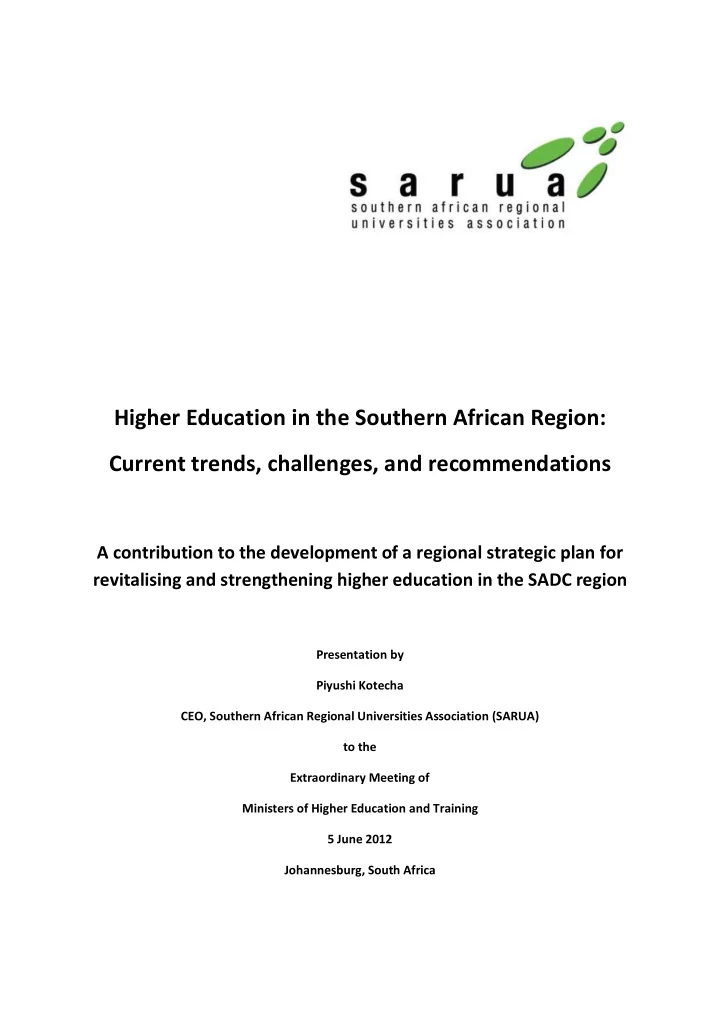

Higher Education in the Southern African Region: Current trends, challenges, and recommendations A contribution to the development of a regional strategic plan for revitalising and strengthening higher education in the SADC region Presentation by Piyushi Kotecha CEO, Southern African Regional Universities Association (SARUA) to the Extraordinary Meeting of Ministers of Higher Education and Training 5 June 2012 Johannesburg, South Africa
Contents Executive summary ........................................................................................................................... 3 Imperatives for change .................................................................................................................. 3 Ten strategies for expanding and transforming higher education in the SADC region ..................... 4 A four-point action plan for revitalising higher education in the SADC region ................................. 5 Introduction ...................................................................................................................................... 6 1 Higher education trends ............................................................................................................ 6 1.1 Enrolment rates ................................................................................................................. 6 1.2 Investment in education..................................................................................................... 7 1.3 Features of higher education provision in SADC countries .................................................. 8 2 Scenarios for higher education in the SADC region ..................................................................... 8 3 Change imperatives ................................................................................................................. 10 4 Strategies for expanding and transforming higher education in the SADC region ..................... 12 4.1 Scale up and modernise the higher education system through ICT infrastructure ............. 13 4.2 Increase the effectiveness of higher education planning .................................................. 14 4.3 Develop academic quality ................................................................................................ 15 4.4 Increase mobility of staff and students across the region ................................................. 16 4.5 Increase the output of doctoral graduates........................................................................ 18 4.6 Strengthen regional cooperation ...................................................................................... 20 4.7 Foster innovation through networks for reflective learning, staff exchange and sharing good practices ............................................................................................................................. 22 4.8 Shift the emphasis towards knowledge diversity, interdisciplinary knowledge practices and southern scholarship ................................................................................................................... 24 4.9 Develop a funding focus for higher education .................................................................. 25 4.10 Strengthen governance, leadership and management in SADC higher education .............. 25 5 Recommendations for the Technical Committee on Higher Education ..................................... 27 References ...................................................................................................................................... 28 Higher education in the Southern African region: Current trends, challenges, and recommendations Presentation by the Southern African Regional Universities Association to the Extraordinary Ministerial Summit 5 June 2012 2
Executive summary Although there is an increasing demand for higher education in the Southern Africa region, levels of higher education provision and enrolment rates in the Southern African Development Community (SADC) countries are amongst the lowest in the world. While the SADC region’s tertiary enrolment was on par with other parts of the world in the 1970s, by 2010 enrolment in those regions had risen by more than 20 per cent and Southern Africa was falling behind. If SADC countries continue along their current higher education trajectory without making significant changes, the region is projected to achieve a 16,3 per cent higher education enrolment rate by 2050. This progress is insufficient when compared to the current global gross tertiary enrolment ratio of 30 per cent, and will erode the future of higher education institutions in the region. The SADC region has invested heavily in education since 1970. SADC countries spend between 4,5 and 5 per cent of GDP annually on education, which is on par with UNESCO’s recommendation (6 per cent of the GDP). By 2010, the SADC region was spending more on education than any other region in the world. SADC also invests more per student than other countries that have a similar level of educational achievement and income. However, an analysis of government spending going to education, rather than education spending as a percentage of GDP overall, shows that most of the investment went towards primary education and less on higher education. As a result, higher education enrolment outcomes reflect poorly on the education investment made. Because increased demand for higher education has not been matched by increased levels of funding, the quality of higher education in the SADC region has deteriorated and the number of academic staff has declined. Higher education systems in the SADC region are elite systems in which demand has outstripped capacity and registrations in the fields of science, engineering and technology are relatively low. Unless the SADC region changes its higher education strategy, by 2050 SADC countries will fall even further behind other regions in Africa and the world in respect of tertiary enrolment rates. Imperatives for change Four imperatives emerge for achieving a step-change in higher education development in the SADC region: • Adopt a strategic, targeted and differentiated approach to the expansion of higher education enrolments at all levels of the higher education pipeline (undergraduate as well as postgraduate study). • Strengthen the quality of teaching and learning in higher education institutions by increasing the qualifications of faculty, producing at least double the number of Masters and doctoral graduates, and retaining these skills within the universities. • Change how universities work in two respects: the first is to strengthen governance, leadership and management, and introduce management information systems to improve the effectiveness of higher education planning and expenditure; the second is to strengthen scholarship through interdisciplinary practice and collaboration for innovation. • Plan how universities develop their research capability . Will they develop research activities in order to achieve a good mix of applied research, a focus on direct technology transfer as well as Higher education in the Southern African region: Current trends, challenges, and recommendations Presentation by the Southern African Regional Universities Association to the Extraordinary Ministerial Summit 5 June 2012 3
Recommend
More recommend